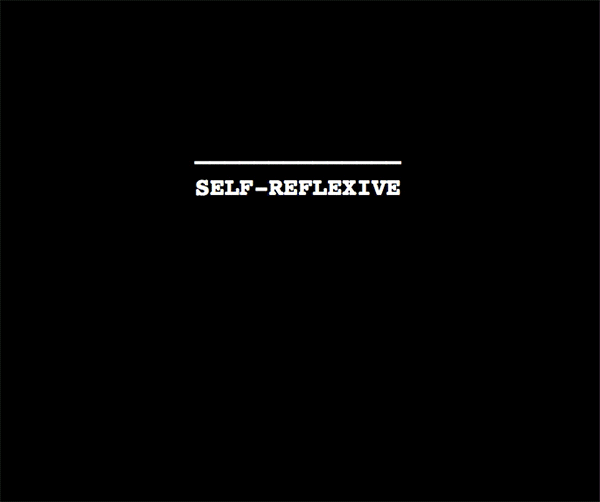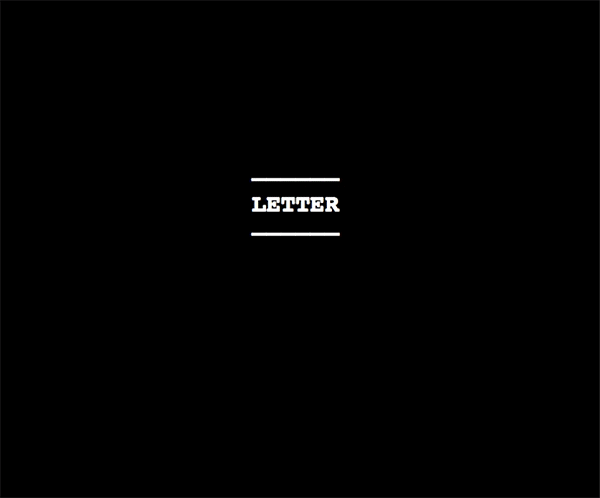
"The future of poetry is with the programmers." - Kenneth Goldsmith
"Does everything that exists, exist to be presented and represented,to be mediated and remediated, to be communicated and translated?" - Alexander R. Galloway, Eugene Thacker, McKenzie Wark, Excommunication.
Kenneth Goldsmith's aphoristic tweet has been coming true for a long time: some version of the "future of poetry" has been happening at least since 1959, when Theo Lutz wrote poems using the programming controls of a Zuse Z22 computer.[1] Since then, a small yet sizeable number of poets have ventured into pre-internet computer poems, yielding an even smaller number of specialists who know about their creative pursuits. Not only that, but digital poems take resources to conserve, programmers who know how to do so and, considering that many of these poems pre-date the internet, they are not as accessible as their successors, such as hypertext narrative.
Given the obscurity of these niche endeavors, it is not surprising that Wired published an article claiming that code poetry was invented in 2011, when a group of engineers noticed the similarities between code and language. But this is not necessarily a new idea: the connection between code and language goes back to its earliest inception. Code is language. It seems only natural that code should be, or would become, poetry.
In fact, this realization came early to digital poets. In the late 1960, the poet Carl Fernbach-Flarhseim asked, of a paper tape program used to randomly compose verses, "If the score is a poem, why not the program which controls the score?"[2] The work done by early digital poets was coincident with the rise of related forms beyond the processor: concrete poetry, in which the visual appearance of the poem is as important as the words comprising the typographical placement, and Oulipo (Ouvroir de littérature potentielle), a movement entirely concerned with implementing and working within stringent linguistic or mathematical constraints.[3]
While these early works primarily used the computer to generate static texts, often for output to film or paper, later poets used the computer to generate dynamic compositions. In the 1980s, poet Barrie Phillip Nichol, more commonly known by his lower case initials bp, experimented with an Apple IIe 8-bit home computer and the Applesoft BASIC programming language. Unlike previous models of the Apple II, the "enhanced" edition supported up to 1MB of memory, a full ASCII character set and keyboard, and the ability to input upper and lower case letters, as well as other features that simply made it easier to type.[4] At the same time, BASIC (an acronym which vaguely indicates its meaning: Beginner's All-purpose Symbolic Instruction Code) was all about making code more user-friendly. Plus, the machine was becoming less expensive to build.
The result of Nichol's encounter with the machine was First Screening: Computer Poems (1984), a suite of a dozen programmed, visual, and kinetic poems published in an edition of one hundred 5.25" floppy disks. In the printed introduction to the works, included with the diskette, Nichol briefly recounts the long process of programming these poems, highlighting that it took a year and a half to complete the series. Given the simplicity of each poem, however, they appear deceptively effortless. Each poem is composed of one, two, three, or up to six words or letters at the most, with the entire series taking less than ten minutes to view.
Due to research and conservation efforts undertaken by a group of Nichol's friends and fellow poets, First Screening is available online as a viewable, readable resource with several versions and one emulated option enabling interactivity. Reading through the essays, we are reminded of (or can imagine) the difficulty of working with such a new technology, before the mouse and GUI.
The poems in First Screening have many similarities to poems Nichol made before he experimented with digital poetry: repetition, permutation, and movement. Letters, words, and phrases are treated as both linguistic and aesthetic elements of a composition, with the "page" serving as a dynamic space for fluid forms. With a careful, sparse selection of words, Nichol gives the same amount of importance to the words themselves as the way they appear on the page, or move across the screen. Programming enabled Nichol to employ these properties to their fullest, so that his computer poems are more effective than those in print: Motion isn't implied, as it would be in print; instead, it is actively happening.
The cover of the booklet could be considered the first poem in the series, with computer-generated drawings rendered as pixelated line tracings.[5] In the opening sequence, a group of nine "O"'s, 3 across and 3 tall, seem to circle around one another in a grid. The series then opens with "SELF-REFLEXIVE NO. 1":

The closeness of "LOST" and "TOSS" is similar to an imperfect rhyme, yet the two words almost touch each other—the T of LOST sliding into the T of TOSS—rather than both ending their respective phrases. The first line appears and the second follows in such rapid succession that they appear almost to happen at once, and the following line comes just as quickly as the preceding line ends. As the lines moves so rapidly, the repeated lines pile up, one after the other, so that the poem begins to scroll as it continues to replicate. This feels very contemporary ("Clicking is through, it's all about scrolling.")—unlike hypertext narrative, which necessitates clicking, Nichol's poems scroll in a predetermined way. What's more, the scrolling that the repetition induces is indicative of the repetitive motion of tossing and turning. The motion of the words is concrete, rather than the words themselves and their form.
"LETTER" begins with the phrase

which then changes by one word into
DOWN TO WRITE YOU THIS POEM SAT
going through each word of the phrase so that the first word of the phrase reappears at the end, and an entirely new sentence comprising the same words follows in the sequence so that the poem ends like this
POEM SAT DOWN TO WRITE YOU THIS
In its transformation, the last line becomes indicative of the process of "reading writing interfaces," as described by Lori Emerson in her book of the same title, with the poem serving as the interface that needs to be activated, mediating "between writer and text as well as between writer and reader."[6] You sat down to write the poem; the poem sat down to write you. In the preface to her book, Emerson states, "Reading Writing Interfaces…is about demystifying devices—especially writerly demystification—by opening up how exactly interfaces limit and create certain creative possibilities."[7] Nichol's First Screening exemplifies this for Emerson, as the "reader/user" had to type in commands. The program also prompted reader/users to look and engage with the text further, with a "hidden" poem at the end, and with access to the .txt file, meaning the code was meant to be investigated and free to be augmented, or at least viewed, by any person curious enough to open the file. Through this, both the writerly process and the device are demystified, enabling reader/users to see and enact the program, and to remember that we are interfacing with an interface, that there is an exchange happening behind the screen, or off it, as bpNichol alludes to from the poem entitled "OFF-SCREEN ROMANCE."
The poems in First Screening were the first and last Nichol ever wrote for the computer; he passed away in 1988. The title implies that there could be a second screening, or maybe it simply meant that this is the first instance of something. Because of the small selection of works, I compared his pre-digital poems with his computer poems. What becomes strikingly apparent, aside from the formal elements listed above, is that his work is incredibly methodological; it is almost obsessively experimental, a tendency that is as much that of a writerly one as that of a programmer.
However, unlike written human language, a programming language is often largely the invention of one person: the inventor of that language is therefore the only one who truly grasps all of its intricacies and understands its full potential. Speaking about programming languages and security vulnerabilities at DEF CON ® 20, Dan Kaminsky explains how all of the most successful programming languages are the brainstorm of one guy (note, guy): "There's one guy [sic] who has it in his head." He goes on, "Our languages that are popular are artistic endeavors by one person, supported by others, but one guy's got the vision." Thus, to locate vulnerabilities in any given code requires getting into someone's head, an intense investigation must be undertaken into the structure of a language, how it is organized, its syntax, its logic.
Translation is an entry point for those trying to fully grasp a language: to learn its nuances, colloquialisms, cadences, and irregularities. One pre-digital project of Nichol's, entitled "Translating Translating Apollinaire: A Preliminary Report" (1975-1978, and potentially ongoing among a network of collaborators as an experiment in pedagogy and practice) is a series of poems that reveals the centrality of this methodology to his writing.[8] In the introduction, Nichol references the first poem he had ever published, written nearly a decade before: Translating Apollinaire (1963), in bill bissett's Blew Ointment magazine circa 1964.[9] Describing the experiment, Nichol writes "I...decided to put that poem thru as many translation/ transformation processes as i & other people could think of. I conceived of it as an openended, probably unpublishable in its entirety, piece. [sic]"[10]
While Nichol eagerly began experimenting with the capabilities of Apple IIe upon its release, the novelty of the tool was not necessarily the allure, though that is the story often told with new media practices. In this instance, the tool enables the practice and, in turn, the form. The poems were experiments in formalism, concerned with properties and their output, and not necessarily the (probably unpublishable) content of the poem—with process, rather than its resulting object. This emphasis on process is what made the computer such a suitable environment for Nichol's work, and—given the fact that this process was partly enacted by the computer—what makes it so inseparable from its original technological context.
Related: Brian Droitcour's The Animated Reader, a poetry collection published as part of the New Museum's 2015 Triennial: Surround Audience, and Harry Burke's Poetry as Practice, a First Look exhibition co-presented by Rhizome and the New Museum, now on view.
Notes

